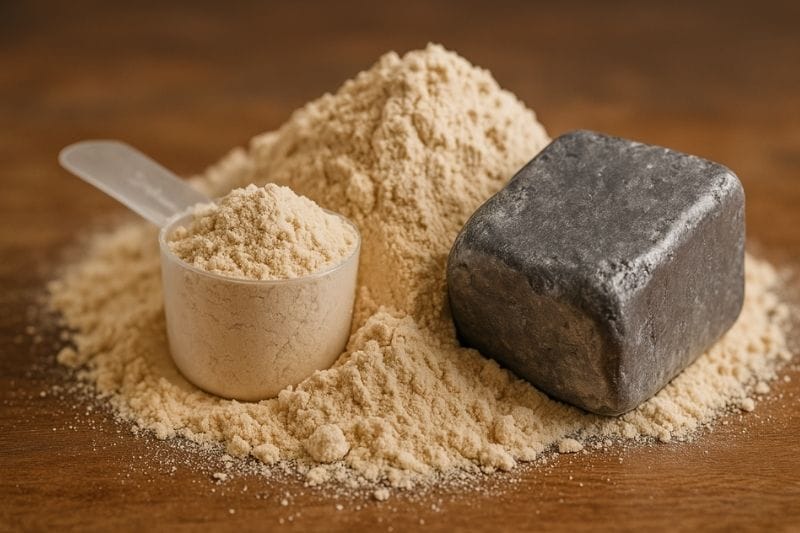A new investigation has found elevated lead levels in many popular protein powders and shakes, raising questions about protein supplement safety.
Protein powders and shakes are everywhere these days. They’re quick, easy, and often seen as an essential part of training or recovery. I always tell clients to get most of their protein from real food, but I understand that shakes and powders can be handy when life gets busy.
So let’s look at what the report found, what might be behind it, and how you can stay safe while still meeting your protein needs.
What The New Report Found
Who Did The Testing
Consumer Reports tested 23 protein powders and ready to drink shakes across dairy, beef, and plant based products. They bought multiple lots between late 2024 and early 2025 and measured heavy metals including lead, cadmium, and inorganic arsenic.
The Benchmark Consumer Reports Used
If you are wondering how much lead is considered safe, the honest answer is that there is not really a safe amount. Lead is a toxic metal, so ideally you want as little as possible. What health bodies do instead is set guidance levels to keep exposure very low.
Consumer Reports uses a very strict limit of 0.5 micrograms per day, which comes from California’s Proposition 65 safety law. It is not a danger line, it is a cautious target that is designed to keep exposure close to zero over a lifetime.
The US Food and Drug Administration (FDA) takes a more practical approach and uses 8.8 micrograms per day as the level that is still considered low risk for adults. For context, most adults already get around 5 micrograms per day of lead from normal food and drink.
In the UK there is no fixed daily limit for how much lead can safely be eaten or drunk. Instead, public health agencies use blood levels to decide when exposure might be too high. They act if blood tests show more than about 5 micrograms per decilitre in children or pregnant women. For everyone else, the aim is simply to keep exposure as low as reasonably achievable.
Method Note: Their weekly and daily limits compare products, they are guidance rather than legal limits, and assume one serving a day unless stated.
Overall Pattern
- Plant based powders tended to show higher lead levels on average than dairy based powders, around nine times higher in these tests.
- Larger serving sizes, such as some mass gainer products, increased the total exposure per serving.
- One product, Muscle Tech 100 Percent Mass Gainer, had no detectable lead in these tests.
Which Protein Powders Did They Test?
Consumer Reports also grouped the products it tested based on the amount of lead detected in a single serving. According to their findings, the products ranked as follows:
Products To Avoid, Zero Servings Per Week
- Naked Nutrition Vegan Mass Gainer
- About 7.7 micrograms of lead per serving in these tests.
- Huel Black Edition
- About 6.3 micrograms of lead per serving in these tests.
Limit To Once A Week
- Garden Of Life Sport Organic Plant Based Protein
- About 564 percent of the Consumer Reports lead level of concern per serving.
- Momentous 100 Percent Plant Protein
- About 476 percent per serving.
Okay To Have Occasionally
Consumer Reports suggests these are not daily choices and sets weekly limits per product:
- MuscleMeds Carnivor Mass
- About 247 percent per serving, up to two and three quarter servings per week.
- Optimum Nutrition Serious Mass
- Driven by inorganic arsenic at about 202 percent per serving, up to three and a half servings per week.
- Jocko Fuel Molk Protein Shake
- About 199 percent per serving, up to three and a half servings per week.
- Vega Premium Sport Plant Based Protein
- About 185 percent per serving, up to three and three quarter servings per week.
- Quest Protein Shake
- About 161 percent per serving, up to four and one third servings per week.
- Orgain Organic Plant Based Protein Powder
- About 143 percent per serving, up to four and three quarter servings per week.
- Optimum Nutrition Gold Standard Protein Shake
- About 150 percent per serving, up to four and two thirds servings per week.
- Equip Foods Prime Protein
- About 144 percent per serving, up to four and three quarter servings per week.
- PlantFusion Complete Protein
- About 140 percent per serving, up to five servings per week.
- Ensure Plant Based Protein Nutrition Shake
- About 132 percent per serving, up to five and one third servings per week.
- Muscle Milk Pro Advanced Nutrition Protein Shake
- About 128 percent per serving, up to five and a half servings per week.
- KOS Organic Superfood Plant ProteinAbout 112 percent per serving, up to six and one quarter servings per week.
Better Choices For Daily Consumption
- Owyn Pro Elite High Protein Shake
- About 88 percent per serving, up to one per day.
- Transparent Labs Mass Gainer
- About 87 percent per serving, up to one per day.
- Optimum Nutrition Gold Standard 100 Percent Whey
- About 56 percent per serving, up to one and three quarter per day.
- BSN Syntha 6 Protein Powder
- About 46 percent per serving, up to two per day.
- Momentous Whey Protein Isolate
- About 30 percent per serving, up to three and one third per day.
- Dymatize Super Mass Gainer
- About 25 percent per serving, up to four per day.
- Muscle Tech 100 Percent Mass GainerLead not detected in these tests.
Other Metals Noted
- Cadmium: Huel Black Edition was about 9.2 micrograms per serving in these tests, above the 4.1 micrograms per day level Consumer Reports cites as potentially harmful for daily intake. Vega Premium Sport also pushed consumers just over that level per serving.
- Inorganic Arsenic: Optimum Nutrition Serious Mass was about 8.5 micrograms per serving, roughly twice the daily level of concern Consumer Reports uses for that metal.
Important Caveats
- This is comparison guidance rather than a legal finding or a recall.
- The figures reflect what was bought and tested at that time. Recipes, suppliers, and sourcing can change.
- Some items have since been discontinued or renamed, and a few brands say they have updated sourcing.
Why Lead Appears In Protein Powders
There are a few reasons this can happen:
- Where the ingredients come from. If crops are grown in soil that naturally contains lead, or if the water supply is contaminated, the plants can absorb it.
- How the product is made. Even if the ingredients start out clean, contamination can happen during blending or packaging if factories do not have tight controls.
- The size of each serving. Some mass gainer products use big scoops, which increases the total amount of whatever is in them.
It is not just about one brand or one type of powder. It is about how ingredients are sourced and how products are made.
What This Means For Consumers
If you use protein powders or shakes regularly, this is something to be aware of, especially if you use them every day.
Here are a few key points:
- The risk seems higher with plant based powders because plants naturally absorb minerals and metals from the soil.
- Larger serving sizes mean higher total exposure.
- Supplements are not regulated in the same way as normal foods, so safety checks can vary.
- This does not mean you should never use protein powders, but it is a good reminder to choose them carefully and not rely on them completely.
My Coaching Perspective, Real Food First, Protein Goals Second
With my clients, whether their goal is weight loss, building muscle, or general fitness, I usually suggest aiming for around 1.2 to 2.0 g of protein per kilogram of body weight each day. The exact protein target depends on things like age, activity level, and goals though. For some we just make sure there is a protein source with each meal, and don’t worry about hitting an overall target.
Here is how I approach it:
- Get most of your protein from food. Lean meat, eggs, dairy, beans, tofu, and lentils all work well. They give you protein along with vitamins and minerals, and there is much less risk of contamination.
- Use powders when needed. They can be useful if you are short on time or travelling, but they should not be your main source of protein. I use them now and again myself, but not daily (or monthly really) but that is more about personal choice – I just prefer real food first.
- Look for transparency. Choose brands that show independent testing results and keep an eye on serving sizes.
- Stay balanced. If you already eat a decent amount of protein through food, you might not need a shake every day.
- Keep an open mind. New reports like this one are a reminder that things change. Stay informed and do not hesitate to switch brands if needed.
Practical Advice, What You Can Do Now
Here are a few easy steps that help reduce the risk:
- Check whether a brand publishes lab results or safety certificates.
- Look for details about ingredient sourcing rather than relying on marketing claims.
- Focus your main meals around food based protein sources and keep shakes for convenience.
- Treat high calorie mass gainer powders as an occasional extra, not a daily habit.
- Read labels, look for independent testing logos such as Informed Choice, and do not assume that plant based automatically means safer.
- For UK readers, remember that this study was US based, but similar issues could occur anywhere. UK supplement rules are different but still rely on brands maintaining good standards.
A Calm Wrap Up
The report does not mean that all protein powders are unsafe, but it is a reminder to think before you scoop.
If you are training hard or trying to improve your health, food should always come first. Protein powders can make life easier, but like any supplement, it is best to know what you are buying and how much you really need.
Focus on good meals, steady habits, and smart choices. That is what makes progress sustainable, and safe.
If you are looking for weight loss and nutrition advice without the confusion, my Weight Loss Coaching programme can help you cut through the noise and find what works in real life.




